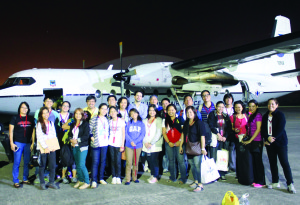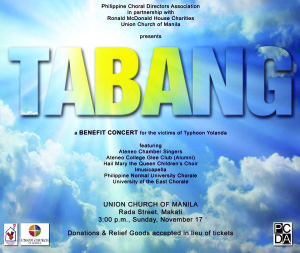Choral World Response to World-Wide Relief
By Jonathan Velasco, choral conductor, President of PCDA
The Philippines had more than their usual quota of natural disasters last year. On October 15, a powerful quake of 7.2 magnitude rocked the islands of Bohol and Cebu, killing more than two hundred people and destroying buildings and churches that were as old as the introduction of Christianity to the country in the 1600s. The area affected included Loboc Church, where the award-winning Loboc Children’s Choir was in residence. The choir members escaped unscathed, but their church was in ruins. Barely three weeks later, the typhoon came.
At the start of November, Manila-based choir conductor Joel Aquino was preparing his STEFTI children’s choir for the national choral competition in Manila to take place at the end of the month. Joel had to fly to Tacloban City, where the choir was based, for each rehearsal. The stakes were high: the choir is one of only six children’s choirs qualified to sing in the national competition.
Philippine Philharmonic Orchestra, conductor Olivier Ochanine, leading a group of instrumentalists and choir singers on Christmas Day 2013 to serenade the people of Tacloban City. Photo by Olivier Ochanine.
On November 8, 2013, typhoon Haiyan made landfall in Guiuan, Eastern Samar, in the Philippines. It was the strongest storm ever recorded on landfall, and is probably the strongest typhoon ever recorded in terms of wind speed. The typhoon brought with it a storm surge of five to six meters in height, washing away flimsy houses on the shorelines, tossing cars and trucks around like toys, and depositing huge merchant ships inland. It passed by the heavily populated city of Tacloban before doing what the New York Times described as “a deadly form of hopscotch,” making five more landfalls across the central islands (including Cebu) before exiting the Philippines.
Haiyan cut a huge swathe of destruction, obliterating entire cities, and toppling and uprooting coconut trees in mountain after mountain. 6,201 lives were lost; thousands more people are still missing. Damage to agriculture and infrastructure totaled almost 880 million US dollars. Escaping with just the clothes on their backs, survivors soon faced a severe humanitarian crisis, with no immediate aid arriving: no food and water, and no police to provide peace and order. The dead lying in the streets had nobody to bury them.
Philippine Choral Directors Association (PCDA) spearheads a series of choral concerts (Tabang means Help) for the benefit of typhoon victims.
After several days of paralysis due to the breakdown in communications, impassable roads, and a totally destroyed airport, the world swung into action. Help immediately poured in from all corners of the globe. Touched by the images on television, various governments and non-government institutions immediately sent money, ships, relief goods, medical personnel, tents, body bags, planes and rescue workers. Filipinos from all parts of the globe contributed to the massive relief efforts by organizing events and donating from their own pockets.
The choral world was not far behind. The Philippine Choral Directors Association (PCDA) launched a series of weekend concerts in November and December, with relief goods and cash donations serving as tickets to the events. The provincial chapters of the PCDA also swung into action, organizing fundraising concerts in churches and malls. Many choirs joined in, especially in the big cities of Metro Manila, Metro Cebu and Metro Davao. The celebration of World Choral Day in those cities reinforced these fundraising efforts.
Fundraising concert in Los Angeles, California for the typhoon victims.
The International Federation for Choral Music (IFCM) encouraged its members to celebrate World Choral Day last December by giving to any relief effort in the world that they chose, with a special appeal made for the Philippine situation. The European Choral Association-Europa Cantat sent out a call to its members to participate in the relief efforts by making a contribution to the Philippine National Red Cross.
Choirs like Philomela and Grex Musicus, both conducted by Marjukka Riihimäki, presented a concert on December 17, 2013, with proceeds going to the relief efforts. The choir of the Nagaland Conservatory of Music in Nagaland, India, presented a benefit concert entitled “Paraiso” on December 4. In the United States, Filipino-Americans spearheaded efforts to put on concerts, notably on the West Coast, where many Filipinos reside. The New Zealand Youth Choir, on tour of the United States, was able to sing at a concert held on November 17 at the Cathedral of Our Lady of the Angels in Los Angeles, California, while three Singapore-based Filipino choirs headed by Psalmi Deo Chorale performed a concert entitled “Songs of Hope” in Singapore. The SYC Ensemble Singers of Singapore dedicated its anniversary concert featuring Filipino Christmas songs to the victims of the typhoon.
The choirs of the world were united in song, directing their voices and spirit toward the city of Tacloban and all the other cities hit by Typhoon Haiyan. In the end, Joel Aquino found his choir members, one child at a time. Sadly, he has no more choir. The children have scattered all over the country, living with friends and relatives, while their beloved city struggles to rehabilitate itself. With help from humanity, with choirs singing in unison, the people of the islands make their way back to the land of the living.
Edited by Marvin Vann, USA


